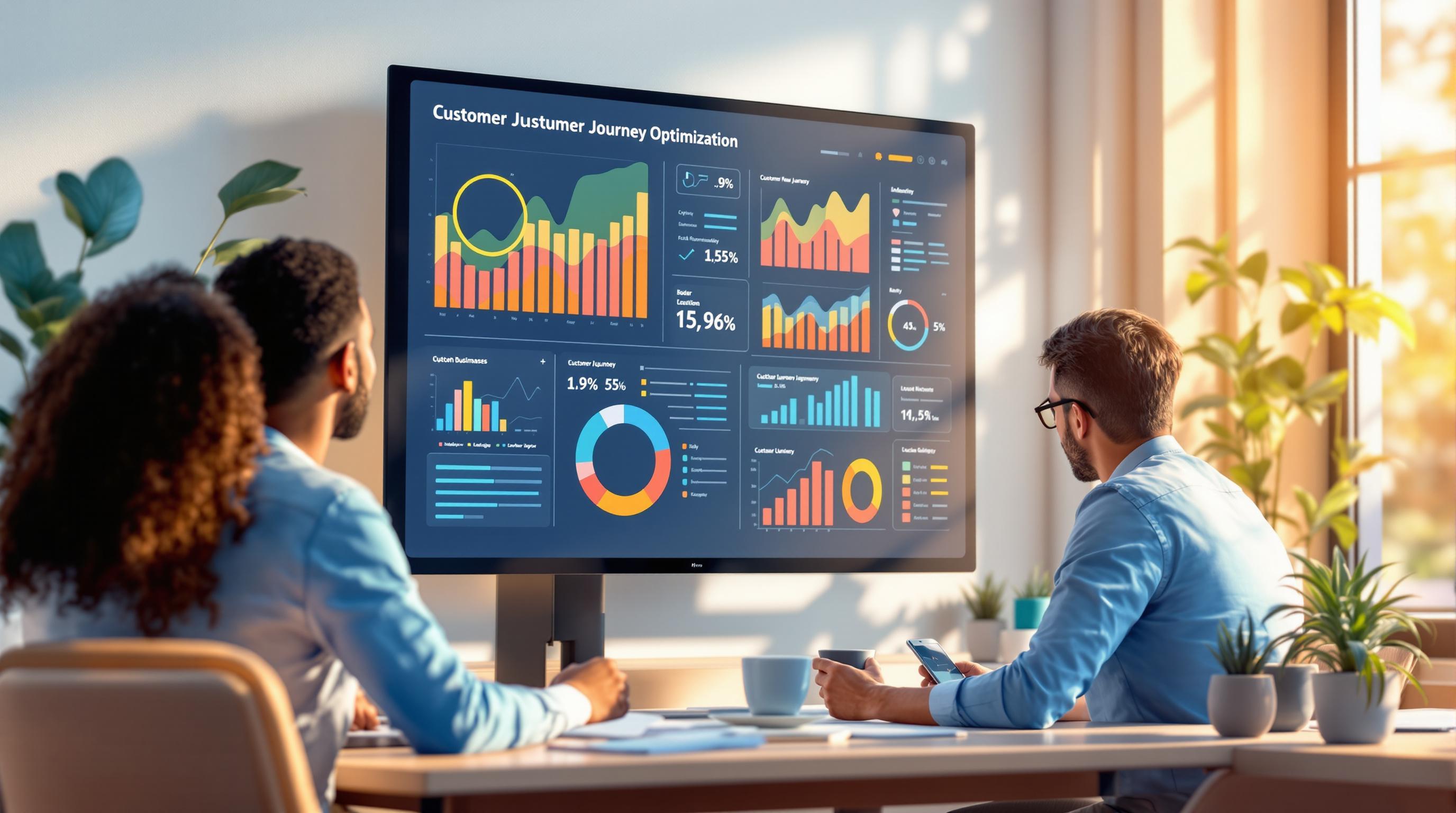Want to improve your audience engagement in 2024? Start by tracking these 6 key metrics:
-
Average Session Duration: Measures how long visitors stay on your site. Longer sessions often mean higher interest.
Tip: Create engaging content and improve site navigation. -
Bounce Rate: Tracks how many visitors leave after viewing one page. A high rate signals issues like slow load times or irrelevant content.
Target: Keep bounce rates below 40%. -
Click-Through Rate (CTR): Shows how often users click on your links.
Formula: (Clicks ÷ Impressions) × 100.
Good CTR: 3-5% for search ads, 4-6% for email campaigns. -
Social Shares: Reflects how often your content is shared across platforms like LinkedIn, Twitter, and Instagram.
Focus: Quality content that resonates with your audience. -
Time Spent on Page: Indicates how well your content holds attention.
Goal: Aim for 1-3 minutes or higher. -
Engagement Rate: Measures overall interaction (likes, comments, shares) compared to your total audience.
Formula: (Total Interactions ÷ Total Reach) × 100.
Good Rate: 1-5% on social media.
Why These Matter: These metrics provide actionable insights into user behavior, helping you refine your content, improve user experience, and drive conversions. Use tools like Google Analytics or social media platforms to track and optimize these metrics effectively.
Engagement metrics in Google Analytics 4

1. Average Session Duration
Average session duration tracks how long visitors stay on your website during a single visit. It provides a clear picture of user engagement and interest.
Why It Matters: This metric shows whether your content holds visitors' attention, which can directly influence conversions [2].
Key Benchmarks: Sessions lasting less than 30–60 seconds may point to issues like irrelevant content, confusing navigation, or slow load times [2].
How to Measure It: Look for patterns over time, break down the data by traffic source and audience demographics, and compare it with other metrics like bounce rate.
Ways to Improve: To increase session duration, focus on creating content that resonates with your audience and make your site easier to navigate. Tools like Google Analytics can help you understand user behavior and identify which pages perform best [2]. Enhancing session duration can lead to stronger engagement across other key metrics.
2. Bounce Rate
Bounce rate represents the percentage of visitors who leave your website after viewing just one page. It’s a clear indicator of how well your content grabs attention and keeps users engaged right from the start.
Why It Matters: A high bounce rate often points to issues like poor user experience, irrelevant content, or slow loading times - problems that can hurt both engagement and conversions [2].
Key Benchmarks: Generally, bounce rates between 26-40% are considered typical across industries. If your rate exceeds 55%, it’s a red flag that needs immediate action. Leading websites often achieve bounce rates in the 20-30% range [2].
How to Improve: To lower your bounce rate, focus on:
- Speeding up your site’s loading time
- Crafting content that matches user intent
- Simplifying navigation to make your site easier to use
Each of these efforts can help keep visitors on your site longer [2][5].
"A high bounce rate can be a major obstacle to achieving your website's goals. By understanding what causes visitors to bounce and taking steps to address those issues, you can improve user engagement and increase conversions." - HubSpot [2]
Measurement Strategy: Don’t look at bounce rate in isolation. Pair it with other metrics like session duration to get a fuller picture of user behavior. For example, a high bounce rate with long session times might mean users quickly find what they need, while low engagement could signal problems with your content or site design [2][5].
Impact on Marketing Strategy: Lowering your bounce rate helps retain users and creates more chances for conversions. Break down the data by traffic source, device, and page type to pinpoint specific areas for improvement [2][3].
Bounce rate gives insights into initial user retention, but to understand how well your content drives action, we’ll move on to the click-through rate next.
3. Click-Through Rate (CTR)
Click-Through Rate (CTR) shows the percentage of people who click on a link after seeing it - whether it’s in search results, emails, or ads. It’s a clear indicator of how well your content grabs attention and encourages action.
How It’s Calculated: CTR = (Clicks ÷ Impressions) × 100. For instance, if 100 people see your link and 5 click on it, your CTR is 5% [1].
Why It Matters: A strong CTR means your content is attracting interest and driving traffic. For example, improving CTR can increase site visits by up to 45% [1]. It’s not just about clicks - it’s about showing how engaging and effective your content is.
| Content Type | Average CTR | Good CTR | Excellent CTR |
|---|---|---|---|
| Search Ads | 1.5-2% | 3-5% | >5% |
| Email Marketing | 2-3% | 4-6% | >7% |
| Display Ads | 0.5-1% | 1-2% | >2% |
Ways to Improve CTR:
- Craft headlines that match search intent.
- Write meta descriptions that encourage action.
- Test different versions of your content (A/B testing).
- Make sure your content directly addresses user needs [1][4].
Using CTR in Your Strategy: Analytics tools can help you track CTR trends and adjust your approach. In fact, 70% of marketers are focusing on engagement metrics like CTR for their 2024 plans [1].
How CTR Fits with Other Metrics: CTR works alongside other engagement stats to give a full picture of how your content performs [1][2].
If boosting CTR is a priority, tools from the Marketing Analytics Tools Directory can help you track and improve this metric, along with other engagement indicators. These tools make it easier to spot areas for improvement and measure progress.
While CTR focuses on getting clicks, the next step - social shares - shows how your audience helps spread your content’s reach.
sbb-itb-5174ba0
4. Social Shares
Social shares show how often your content is shared on social media platforms. This gives you a clear idea of how engaging and relevant your audience finds your content - enough to share it with their own networks.
Why Social Shares Matter: When someone shares your content, they’re giving it their personal stamp of approval. This not only increases your reach but also boosts your credibility [1].
Tracking Social Share Performance: Keep an eye on key metrics like LinkedIn reshares, Twitter retweets, and Instagram story shares. Each platform offers different insights:
| Platform | Key Metrics | Importance |
|---|---|---|
| Reshares, Comments | Builds professional trust | |
| Retweets, Quotes | Shows potential for virality | |
| Shares, Reactions | Highlights community connection | |
| Saves, Story Shares | Measures visual appeal |
Focus on Quality, Not Just Numbers: Don’t just count shares - dig deeper. Look at comments, website traffic, and conversions to evaluate how impactful those shares really are [2].
How to Get More Shares: Publish content that’s relevant and engaging. High-quality posts are more likely to be shared [1][2].
Using Social Share Data Strategically: By analyzing what gets shared the most, you can pinpoint the type of content your audience loves. This helps refine your strategy to drive even more engagement [1][2].
Social shares not only amplify your content’s reach but also complement other metrics like click-through rates (CTR). To get a fuller picture of user engagement, pair social share data with metrics like time spent on page.
5. Time Spent on Page
Time spent on a page shows how well your content holds a visitor's attention. It's a key indicator of how relevant and engaging your content is.
Why It Matters: This metric ties closely to business results, offering insights that can shape your content strategy [1].
Here’s how time spent on a page typically reflects engagement:
| Time Span | Engagement Level | Likely Outcome |
|---|---|---|
| Under 30 seconds | Low engagement | High bounce rate, minimal conversions |
| 30-60 seconds | Limited engagement | Users skim content |
| 1-3 minutes | Moderate engagement | Content resonates with users |
| 3+ minutes | High engagement | Strong chance of conversion |
How to Measure It: Use analytics tools to dig into user behavior and track time spent on your pages. Focus on:
- Which sections of your content hold the most attention
- Where users tend to leave the page
- Engagement differences across devices
- Connections between time spent and conversions
Ways to Improve: To keep visitors on your page longer:
- Break your content into clear sections with headers and use mobile-friendly layouts.
- Add visuals or interactive elements to make the page more engaging.
- Place key information where it’s easy to spot.
What to Watch Out For: Be cautious of artificially high times caused by users leaving the browser tab open. Pair this data with other metrics, like scroll depth, for a clearer picture of engagement [2].
Using this metric effectively helps marketers create content that better matches what their audience wants, leading to more engagement and conversions.
For tools to track and analyze this data, check out the Marketing Analytics Tools Directory. It’s a great resource for finding solutions to monitor user behavior and content performance.
While time spent on a page focuses on content engagement, the next metric - Engagement Rate - offers a broader look at how your audience interacts overall.
6. Engagement Rate
Engagement rate measures how actively users interact with your content - through likes, shares, and comments - compared to the total number of viewers. It builds on other metrics like CTR and social shares, giving insight into how well your content resonates with your audience [1].
Key Components of Engagement Rate:
| Platform | Indicators of Value | Typical Range |
|---|---|---|
| Social Media | Community interaction, advocacy | 1-5% |
| Website | Purchase intent, lead quality | 2-4% |
| Relevance, audience loyalty | 15-25% | |
| Blog Content | Authority, audience trust | 0.5-3% |
Why It’s Important: Engagement rate highlights how well your content fosters connections with your audience. Strong engagement often leads to better brand loyalty and a higher chance of conversions [1].
How to Measure It:
(Total Interactions ÷ Total Reach) × 100 = Engagement Rate
Brands that monitor engagement rates are 60% more likely to achieve success in social campaigns, showing its strong link to effective marketing [1].
How to Improve Engagement:
- Focus on content that sparks discussions and includes clear calls-to-action.
- Post during times when your audience is most active.
- Add multimedia elements like videos or images to make content more engaging.
- Respond quickly to comments to encourage authentic conversations.
Tracking Tools: Many analytics platforms can measure engagement, and the Marketing Analytics Tools Directory mentioned earlier offers solutions tailored for tracking engagement across multiple channels.
Using Analytics Tools
Modern analytics tools help you make smarter content decisions by giving you detailed data and insights.
Key Types of Analytics Tools
| Tool Type | Insights Offered |
|---|---|
| Web Analytics | Tracks session duration, bounce rates, and user behavior |
| Social Media Analytics | Measures engagement rates, social shares, and community impact |
| Content Analytics | Monitors time on page, click-through rates (CTR), and content performance |
| Campaign Analytics | Analyzes CTR, conversion rates, and campaign ROI |
Pick tools that align with your specific goals. For instance, Google Analytics is great for website data, while social media tools like Hootsuite or Sprout Social dive deeper into engagement metrics.
Best Practices for Using Analytics Tools
- Define Clear Goals: Focus on metrics that match your engagement or conversion objectives. Avoid collecting data that doesn’t serve a purpose.
- Set Up Tools Correctly: Make sure tracking codes are installed properly and run regular audits to ensure your data is accurate.
- Review and Optimize Regularly: Check your analytics on a consistent schedule. Use the data to spot trends and fine-tune your content or campaigns.
Picking the Right Tools
The Marketing Analytics Tools Directory can help you find solutions that meet your needs. Look for features like:
- Real-time tracking
- Integration across platforms
- Customizable reports
- A/B testing options
- Predictive insights
- Tools for audience segmentation
Choosing the right analytics tools and using them effectively can make a big difference in how you measure and improve your content performance.
Conclusion
Audience engagement metrics give marketers a clear picture of how users interact with content. They can help improve relevance, refine the user experience, and build stronger brand connections.
Looking at metrics together, like bounce rate and time spent on a page, provides deeper insights. For instance, a high bounce rate combined with a long time on the page may indicate successful single-page content rather than poor engagement. Similarly, high social shares paired with strong engagement rates show that your content hits the mark with your audience.
Analytics tools simplify tracking these metrics. Whether you're using platforms like Google Analytics or tools tailored for social media, the focus should be on:
- Crafting engaging and relevant content
- Improving the user experience across devices
- Strengthening audience relationships
- Making informed, data-driven decisions
Platforms mentioned earlier, such as those in the Marketing Analytics Tools Directory, can help you monitor and enhance these metrics effectively.
These metrics represent actual user behavior. By acting on these insights, marketers can boost engagement and drive growth. Using the right strategies and tools, you can turn audience interaction into a reliable growth engine for 2024.


